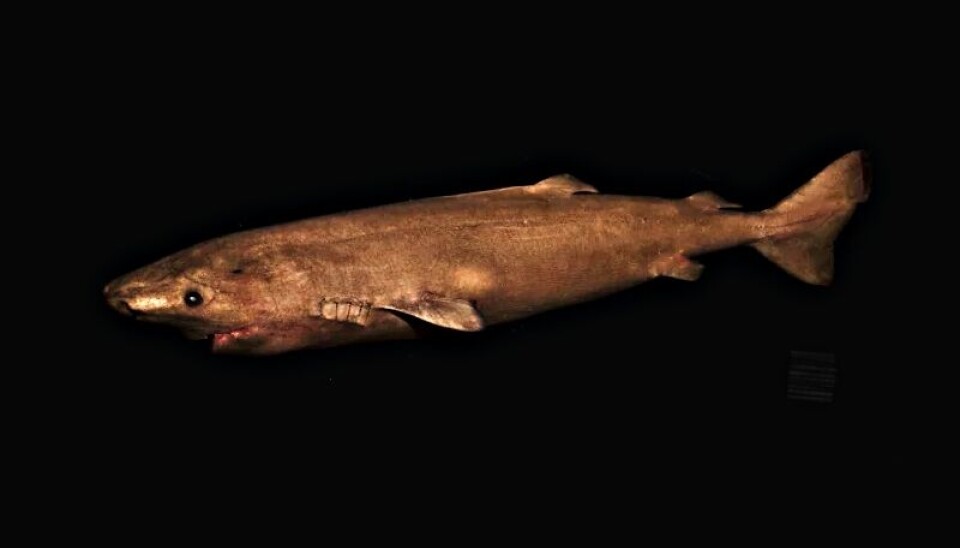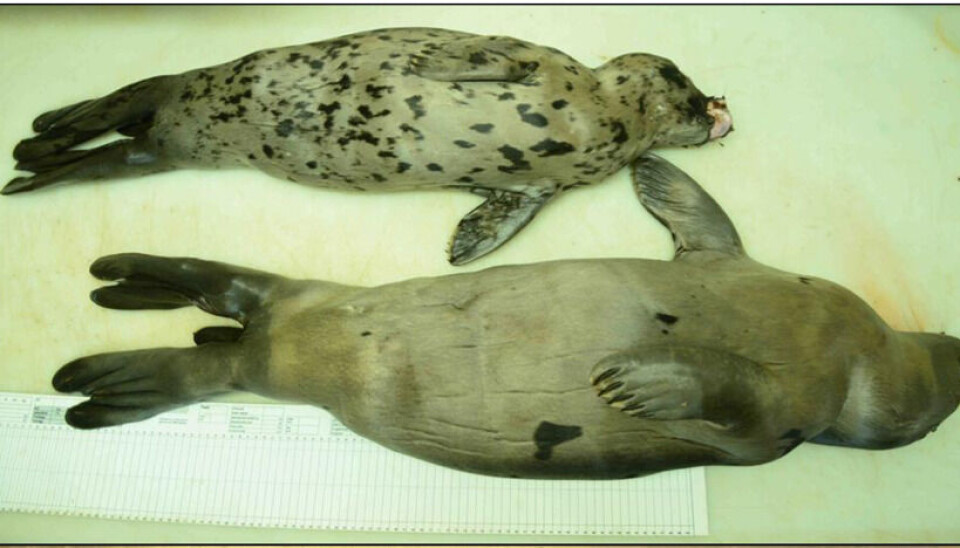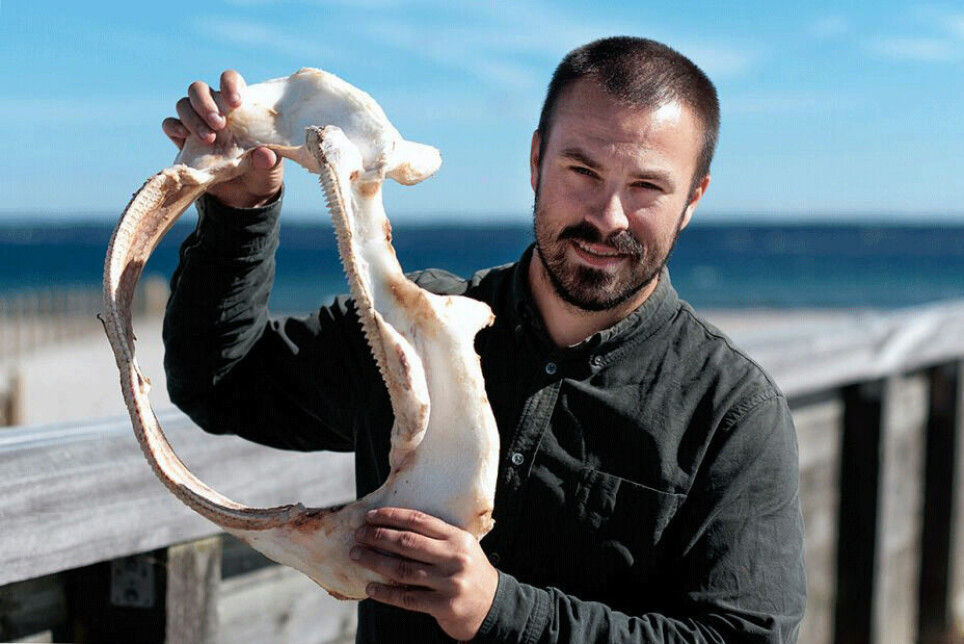
This shark postpones having sex until it is over 100 years old
Not that strange perhaps, now that we know how long the mysterious Greenland shark can live.
Scientists are closing in on more answers about this strange animal.
Where does the Greenland shark have sex after living for 100 to 150 years?
Does mating happen in a very special place in Lofoten in Northern Norway? Or does it happen somewhere far out in the Atlantic Ocean south of Iceland?
Where does it give birth to its offspring?
Two million Greenland sharks have been caught. But only once has anyone come across this shark with a baby in its belly.
Tonnes we still don't know
“There’s still so much we don't know about this deep-sea shark,” says Jørgen Schou Christiansen.
He is one of several Danish researchers based at Norwegian, Greenlandic and Danish research institutions who are trying to find out more about one of the ocean's most mysterious animals.
Christiansen originally comes from Greenland. He has just retired from his position as professor of Arctic and marine biology at UiT – The Arctic University of Norway in Tromsø.
“We don't know how many young the female shark can have. We still know very little about the population size. Its migration pattern is also almost completely unknown to us," he says.
But the fact that the Greenland shark may live as long as 400 years is no small thing to have discovered, according to the researcher.
“This shark’s lifespan is a solid record among vertebrates.”
Extremely original research lies behind this startling discovery. It was based on the nuclear bombs detonated by the Soviet Union and the United States in the 1950s. More on that later in this article.
Very slow moving
Sharks appeared around 450 million years ago.
They originated long before dinosaurs started roaming the Earth or trees began to grow.
The Greenland shark (Somniosus microcephalus) belongs to a family of sharks that appeared over 100 million years ago known as sleeper sharks.
This fish, which is up to 5.5 metres long and sometimes weighs more than a tonne, usually swims around at a speed of just over one kilometre per hour. That's a third of a person's walking speed.
Sleeper sharks have plenty of time.
Nevertheless, the researchers now believe that the fish can travel hundreds and thousands of kilometres within a few months.
Perhaps some of these animals circumnavigate the Earth.
Swallow live seals
Julius Nielsen is one of the researchers who is taking over the baton from Christiansen.
He is also Danish, has been a researcher in Tromsø and then worked at the Greenland Institute of Natural Resources in Nuuk. Now he is transferring the Greenland shark research to the Natural History Museum in Copenhagen.
“The Greenland shark’s age is one thing. But we’re also interested in what it eats,” Nielsen says.
Because how can a Greenland shark catch any food at all when it’s so sluggish?
One hypothesis has been that this shark is exclusively a big "trash bin" and that its menu only consists of dead animals and carrion remains.
But how can we then explain that fishermen find whole seals, which were apparently recently alive, inside the stomach of sleeper sharks?

The shark hardly has particularly well-developed vision, which may not improve matters.
Often a white parasite has been found hanging out of the shark's eyes. Some researchers believe this prevents the shark from being able to see well. But Nielsen points out that this remains to be proven scientifically. He adds that it is often completely dark in the depths where the shark lives. So it may not have much use for vision anyway.
One hypothesis is that the shark is able to swim forward silently, without a single sound, enabling it to get right up close to cod and seals.
“Then it just opens its mouth quickly and creates a negative pressure inside the mouth,” says Nielsen.
“That's how whole seals can disappear into the shark's stomach.”
Very special animal
“Remember that the Greenland shark is a very special animal.”
In order to learn more about this animal, we need to be able to follow it from place to place in the ocean, says Nielsen.
“For example, we have no idea where Greenland sharks give birth to their young.”
Nielsen mentions a hypothesis which states that their birthing happens in an area in the Atlantic Ocean south of Iceland.
So far, scientists are reasonably certain that the shark can travel hundreds and thousands of kilometres in the Atlantic Ocean over the course of a few months.
“But where the sexually mature females and males meet each other after waiting for over a hundred years is still an open question,” Nielsen says.

Between 272 and 512 years old
It was Julius Nielsen who, in his doctorate in 2017, was able to state that the Greenland shark must be the world's oldest vertebrate. The research became an article in the well-known research journal Science.
Researchers at the University of Tromsø, the Greenland Institute of Natural Resources, the University of Copenhagen, Aarhus University, Indiana University South Bend and the University of Oxford all collaborated on the highly original research.
Using traces from nuclear tests in the 1950s that were found inside the eyes of 28 Greenland sharks, Nielsen and his colleagues were able to determine that the oldest of these animals must be somewhere between 272 and 512 years old.
Therefore, it is not improbable that a Greenland shark can live up to at least 400 years old.
Regardless of which age the researchers found to be correct, this is a solid record among larger animals.
Turtles and bowhead whales have been considered the world's oldest vertebrates in the past.
Just an estimate
Today, Nielsen is careful to emphasize that he has not established as absolutely certain that a Greenland shark can live to be 400 or perhaps 500 years old.
That is what the media around the world reported five years ago, after the Science article was published.
“We had just made an estimate,” Nielsen says.
“What we do know is that this shark can live to be hundreds of years old. But we still don't know for sure whether that means 200, 300 or 400 years old.”
“It’s difficult to make more precise age estimates than this with the methods we have available today. But it could well be that we’ll be able to improve the estimates in the future,” he says.

Two million animals caught
Why so many of these sharks apparently exist is another great shark mystery. Particularly large numbers of them are found around Greenland.
The researchers have calculated that over the past 50 years more than two million Greenland sharks have been caught around Greenland alone.
Many of them have been caught as bycatch in connection with other targeted fish species. And some have been used as a raw material for the Danes' "Trekroner tran", a lamp oil that was used to light up Danish and Greenlandic homes.
But how can an animal that waits for 100 years to have young withstand such great hunting pressure from humans?
Why haven't Greenland sharks become endangered?
Only a single animal found with young
One hypothesis is that when a Greenland shark starts to have offspring, she gives birth to a lot of young at the same time.
But even though so many Greenland sharks have been caught over the years, it’s rare that anyone has pulled up a pregnant female. The young must therefore be born in completely different places than Greenland and Norway.
The size of the pregnant females that have been found – almost 4 metres – and the knowledge of how slowly the Greenland shark grows, have allowed the researchers to conclude that this animal does not mate until it is at least 100 years old and probably even 150 years old.
Only once has anyone seen a female Greenland shark with a baby in her belly. That shark had ten foetuses.
“For many years it was therefore believed that the fish gave birth to about ten children at a time,” says Nielsen.
“But now we’re speculating whether these offspring were only a small part of a much larger pregnancy.”

Radio tagging 40 sharks
The work carried out by researchers in Greenland now points towards the female Greenland shark, once she gets her sex life up and running, giving birth to hundreds of young each time she becomes pregnant.
That would be another record in the shark world.
Maybe this hypothesis can help to explain how an animal can wait to mate for over 100 years – and survive being caught in large numbers.
Now researchers in Greenland, Tromsø and Copenhagen are collaborating to radio tag 40 Greenland sharks which will be followed by satellites.
Can they find out where this mysterious deep-sea shark mates? And where it gives birth to its living young?
Hunting for Greenland shark’s DNA
Another Dane, researcher Kim Præbel, is at the Norwegian College of Fishery Science at the University of Tromsø.
Præbel is on the hunt for the Greenland shark's secrets from another, somewhat special angle, through its DNA.
The shark's genetic material could yield more exciting research results in the future, he notes. He can’t go into much detail, because the research has not yet been published.
“But it involves this fish living so long, so studying its DNA is quite interesting,” he says to sciencenorway.no.
And offers a small reveal: “DNA from Greenland sharks along the coast of Norway shows a completely different genetic structure than we had expected.”

Can swim unbelievably far
“One thing we’ve found is a Greenland shark in Norway that genetically has more in common with Greenland sharks in West Greenland and Canada than it has with other Greenland sharks in Norway.”
“How can this be?” asks the researcher, and suggests an answer.
“In principle, a Greenland shark could swim around the earth several times during its life, even swimming really slowly.”
Whole Earth is home
Præbel believes this animal makes the whole Earth its home.
This could possibly leave an imprint in the animal's genes, according to the DNA researcher.
“Animals that live for hundreds of years probably have a completely different spatial perception of life than other animals,” he says
It has been common to think of the somniosus-sharks, or sleeper sharks as five or six different species of sharks. These species live in various places such as in the Mediterranean, down by Antarctica, in the Pacific Ocean, in the deep sea off Japan and in the North Atlantic.
“Now that we’re starting to examine these sharks' DNA, we find that "species" native to the Pacific Ocean, for example, also roam around Svalbard and the rest of the North Atlantic.”
What might that mean?
Are these really different species of shark?
Præbel says that the researchers have now also come across a unique place where sexually mature females and males have been observed at the same time.
It is in a fjord in Lofoten in Northern Norway.
Præbel promises us a lot of exciting research on Greenland sharks ahead.
Here is a video from when the researchers encountered a Greenland shark:
Translated by: Ingrid P. Nuse
Read the Norwegian version of this article on forskning.no
Sources and references:
Julius Nielsen: "The Greenland shark – the Arctic's overlooked but significant predator", Tidsskriftet Grønland, no. 2/2021 (in Danish).
Julius Nielsen: "The Greenland shark (Somniosus microcephalus) Diet, tracking and radiocarbon age estimates reveal the world's oldest Vertebrate", PhD thesis, University of Copenhagen, November 2017.
Julius Nielsen et al: "Eye lens radiocarbon reveals centuries of longevity in the Greenland shark", Science, 2016, Abstract.
Science: "Greenland shark may live 400 years, smashing longevity record", August 2016.




































